The HP Spectre Folio Review: Luxurious Leather Laptop
by Brett Howse on June 7, 2019 8:00 AM EST- Posted in
- Laptops
- HP
- Spectre
- Amber Lake
- Spectre Folio
Display Analysis
HP offers a couple of different display options in the Spectre Folio. The 1920x1080 13.3-inch display is standard, and if you want to spend a bit more, you can get a 3840x2160 panel. Both are IPS, and the review unit shipped with the standard 1920x1080 display. Although HiDPI is impressive, for reasons we’ll go over in the battery life section of the review, there’s no need to ever upgrade from the 1920x1080 display, which is one of the new generation “1W” displays that Intel has been working on.
The amazing part of the new display is that it doesn’t really sacrifice anything to achieve this level of power savings either, as we’ll get into below. The brightness and contrast are both excellent. You just save a whole bunch of battery life in the process. Displays are easily the biggest power draw in a laptop. A 15-inch Surface Book 2 draws 7.65 W of power just to drive the display at 100% brightness. The rest of the system only draws 1.43 Watts. On that laptop, the display consumes 5.34 times more power than every other component combined. Now, that’s not an apples-to-apples comparison to this HP, of course. The Surface Book 2 we reviewed was a 15-inch model, and has a much higher resolution, so a stronger backlight is required. The HP Spectre Folio’s display at maximum brightness draws just 1.71 Watts.
Display power draw is a huge concern for any battery powered device, and we’ve seen some impressive gains in the smartphone space. PCs have offered technologies such as IGZO and LTPS as TFT solutions to assist with the power draw issue, and it’s great to see Intel working on new techniques as well to combine the better TFT materials with other solutions to really drive down display power.
Next up, let’s look into the display accuracy and other characteristics. To do this, we leverage Portrait Display's CalMAN software suite with an X-Rite i1Display Pro colorimeter for brightness and contrast testing, and an X-Rite i1Pro2 spectrophotometer for color accuracy testing.
Brightness and Contrast
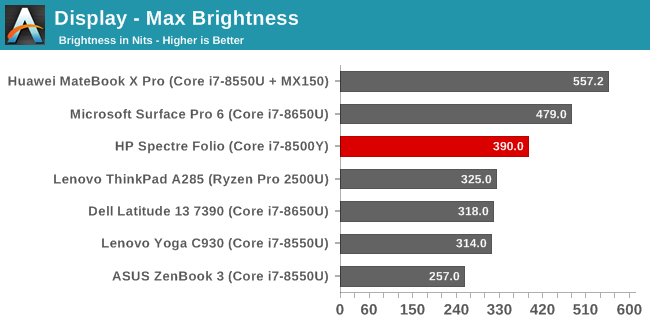
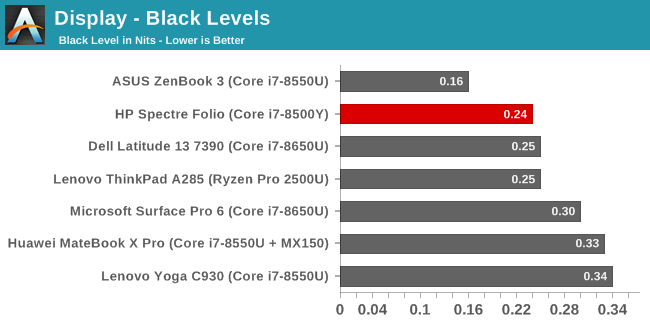
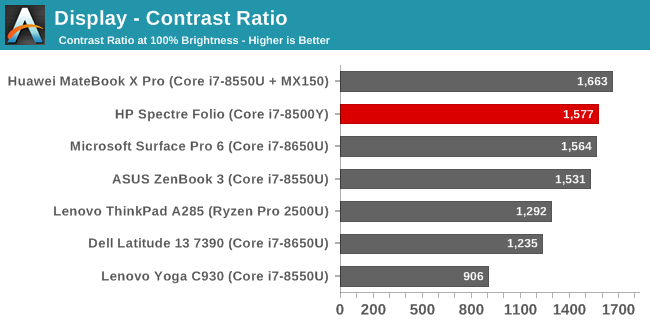
Despite the 1W display panel, the maximum brightness is quite good, offering almost 400 nits of brightness. The black levels are also excellent, which drives the contrast ratio to a very respectable 1577:1.
Grayscale
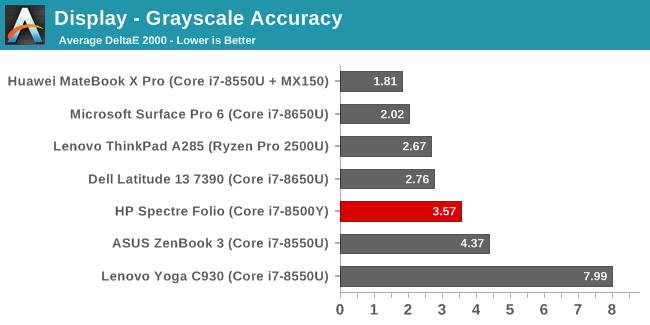
We’ve not tested an HP laptop in some time, but with this grayscale result it’s clear that they are not calibrating their displays at all. The average error level is 3.57 but it peaks over 5 at some parts of the range. In addition, the gamma is far too low.
Gamut
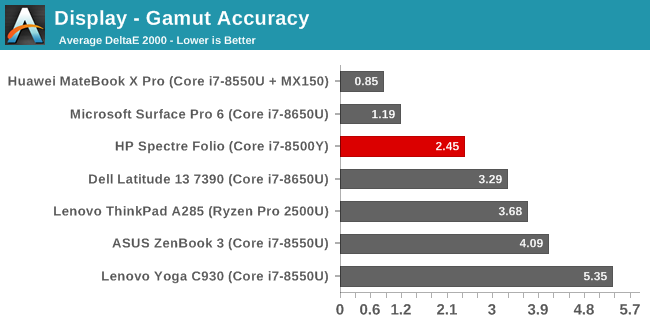
Despite the grayscale being off, the 100% levels for color are actually very close to where they should be, although magenta does drift quite a bit compared to the rest, but even it is still less than a dE of 3.0 which is pretty good.
Saturation
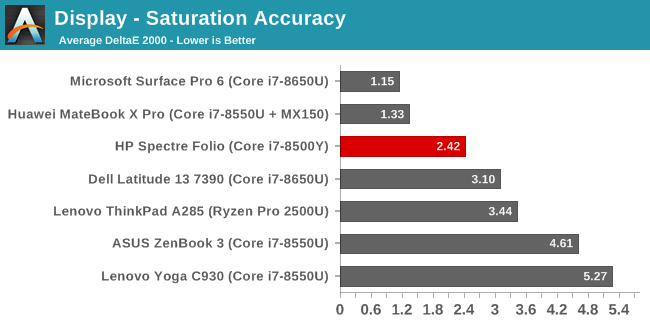
Taking the primary and secondary colors and testing them across the entire range, rather than just the 100% levels is our saturation test. Like gamut, the color accuracy is quite good for an uncalibrated display. Cyan and magenta both drift slightly, but not enough that it should bother anyone for any task that isn’t color-critical.
Gretag Macbeth
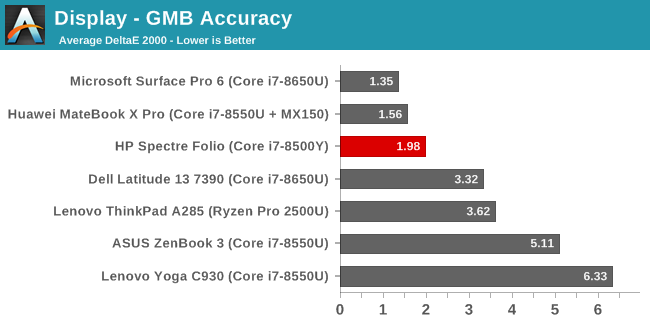
Our final test targets colors across the spectrum, and not just the primary and secondary axis. It includes the important skin tones as well. The overall dE average is very good, and as you can see there’s very few colors that peak over the 3.0 error level line. If the grayscale wasn’t partially included, the results would be even stronger.
Display Accuracy Conclusion
Clearly HP is not calibrating their displays at the factory, but the overall error level is pretty reasonable on this unit. If you are aiming for color accuracy, this would actually be pretty easy to calibrate without causing major issues with banding and such, since the color levels are already very good and it’s just the grayscale and gamma that need to be tweaked.
The low-power display also didn’t lose any brightness, offering almost 400 nits of brightness, and it also offers great contrast. Overall this is a good, but not great, notebook display.


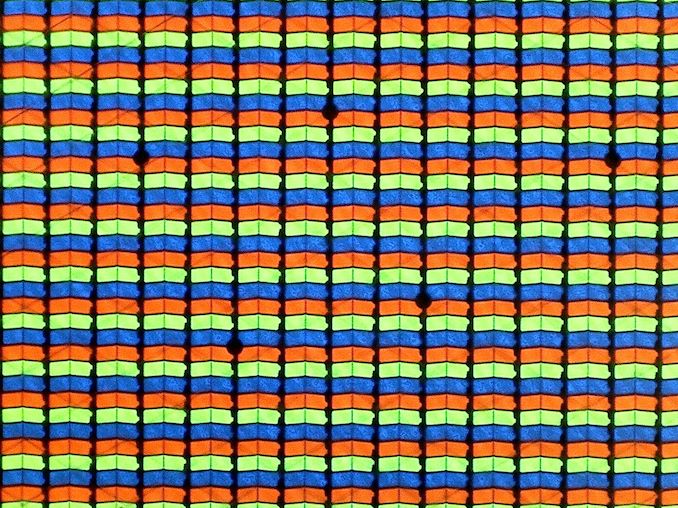












29 Comments
View All Comments
peevee - Friday, June 7, 2019 - link
5W for 2 cores at 1.3GHz.Apple A12 is ~5W for 2 similarly fast (in terms of IPC) cores at ~2.5GHz + 4 slow efficient cores.
10nm fiasco costed Intel a lot.
Retycint - Friday, June 7, 2019 - link
Intel was never really as efficient for mobile (<5W) though, which is why their atom line failed spectacularly. ARM-based processors definitely has the advantage in the low-power fieldKorguz - Friday, June 7, 2019 - link
im sure HStewart will find a way to refute this.. and bash arm based cpus some how...AshlayW - Friday, June 7, 2019 - link
I like the idea of a leather covered laptop, leather feels nice to the touch for me. And it makes a nice change I think. I have an HP ENVY X360 with the Ryzen 2500U in it, and it is a really great little machine and was £649 when I bought it. I can manually set the power limit to 30W and disable the skin temperature throttling for maximum sustained performance. It is around 3.1 GHz all core in multi-thread and 3.4-3.5 GHz in single threaded. In games the GPU can boost to 800-900 MHz and easily beats any Ultrathin Intel iGPU. Also I think at stock the 2500U is heavily throttling so it explains why it gets beaten a lot by this device in the review. (yes I am aware that the whole point is that they are efficient, and yes Intel's processor is more efficient, largely helped by the fact that Intel 14nm+++ has vastly superior power and voltage characteristics to GlobalFoundries 14nmLP/P).As for 5W, in this power envelope, 10/7nm will really, really help a lot here. I think if AMD can get 7nm low power mobile chips out soon-ish, they can have a really big competitive advantage against these 14nm Intel ones. But that said, Ryzen with onboard graphics is usually an entire cycle behind the desktop CPUs without. 12nm 3000-series APU are uninteresting for me, as it is basically 10% or close to that, more performance than my 2500U at the same power use. But I heard the idle power use is vastly improved. Sorry I typed a huge comment.
ikjadoon - Friday, June 7, 2019 - link
Excellent review.This laptop was one of the inspirations for Project Athena, apparently.
>Though the HP Spectre Folio wasn’t explicitly described as a Project Athena device, it’s representative of the collaboration between Intel and its PC partners.
https://www.pcworld.com/article/3331244/intel-proj...
Props to the 1W display. I'd love a deep dive by Anandtech on how 1W (LPDT) panels work. IIRC, they use LTPS backplanes (a-si -> IGZO -> LTPS from worst to best), panel self-refresh, variable refresh rate, more efficient backlights, and some panel microcontroller efficiencies.
https://www.digitaltrends.com/computing/intel-low-...
So a lot of good technologies on their own brought together into a shipping product.
Gc - Friday, June 7, 2019 - link
In 2013, the Sony Fit 13A, 14A, 15A "Flip PCs" had screens that can flip down over the keyboard.https://forums.anandtech.com/threads/sony-vaio-fli...
Spun off, Vaio continued with the Vaio Z Flip in 2016.
https://www.anandtech.com/show/10006/vaio-to-start...
That model still seems to be sold in Japan.
https://vaio.com/products/z131/
Gc - Friday, June 7, 2019 - link
One benefit of the flip-down screen is that it is simpler and quicker to switch between keyboard mode and pen mode for taking notes. Other convertibles require picking up the whole computer, which can disturb your neighbors in a meeting or lecture. A benefit of the leather surfaces might be to quiet any clattering as the pieces fold together.wr3zzz - Friday, June 7, 2019 - link
I pre-order the Folio and have been using it as my daily work machine since. I agree with every point in this review.One thing to note is that Dell just added fans to its XPS 13 2-in-1 so it looks like the Folio could be the only premium fanless notebook with screen larger than 13" left in the market.
ramisingh - Saturday, June 15, 2019 - link
I like this post.Hiwe all recognize that Brother printers are extraordinarily relaxed and compactable printing tool Brother printers are assist you to find out your work productiveness through its wi-fi networking talents. If you are searching Customer Care Support Services to your printer then you can visit our web sites. Thanks,